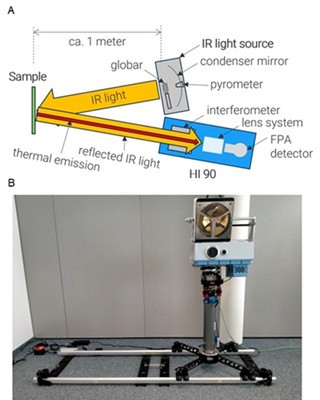
LABORATORY: CNR SCITEC
NAME OF THE INSTRUMENT
HI 90 Bruker Mid-IR hyperspectral imager
GENERAL DESCRIPTION
Reflection FT-IR spectroscopy is widely used in the field of heritage science for the characterization and identification of organic and inorganic materials. Being a vibrational molecular spectroscopic technique, it provides information concerning the functional groups constituting the molecules ultimately aiding a molecular identification of unlimited materials under exam. The mid-FTIR range is particularly adapt for the recognition of inorganic materials (with some limitations from metal oxides) as well as synthetic and natural organic materials. This technique can provide information concerning not only painting materials and techniques, but also any surface contaminations, alterations, and products/processes of degradation.
The HI 90 by Bruker is an advanced hyperspectral imager operating in the mid-infrared (mid-IR) spectral range (4000-800 cm-1), and it is able to provide compositional images of great value for artworks’ knowledge and conservation. Hyperspectral imaging in this highly diagnostic spectral range allows to go beyond pigments identification and their distribution, and to unveiling nature and distribution of the organic materials and degradation products.
TECHNICAL DESCRIPTION
The hyperspectral imager mainly consists of a Michelson interferometer and a Stirling cooled focal-plane-array (FPA) Strained Layer Superlattice (SLS) detector. The plane-mirror interferometer is actively aligned, and the system is sealed and actively cooled. The maximum spectral resolution is 1 cm-1, the measurements are generally carried out at 4 cm-1 typically applied in IR external reflection mode in the 4000-800 cm-1 spectral range. The full size of the FPA detector is 320 x 256 pixels, each pixel is 30x30 µm2. The field of view of an individual pixel is ca. 0.52 mrad, which corresponds to a lateral resolution of better than 1 mm (0.7-0.8 mm) at 1 m working distance. For the preview mode, operating like a thermographic camera, the full size of the detector is used. For normal measurements, the active FPA detector area is 176x176 pixels and the measurement area is ca. 11 x 11 cm2 at 1 m working distance. The noise equivalent temperature difference (NETD) of the measurements with 16 coadds, 3x3 pixel averaging, in the spectral range from 1050 cm-1 to 1150 cm-1 is about 90 mK.
Reflectance spectra are calculated as the ratio between the sample reflection and that recorded from a grey aluminium powdered target used as background.
The hyperspectral images are processed using a linear filter with a Gauß kernel of 3x3 pixels with a width of 3 pixels. To measure in reflection mode, the sample is illuminated by an infrared radiation source consisting of a globar (SiC) light source and a parabolic condenser mirror with a diameter of about 30 cm. The globar is installed on a motorized actuator which is used to adjust the working distance of the source from 1 m up to infinity at the defocused position. During the time for data analysis after each measurement, the actuator is automatically moved to defocus the source, or the source can be temporarily turned off to reduce the radiation exposure of the sample. The temperature, and thus the radiation spectrum and intensity of the source, can be tuned by changing the input electrical power. The intensity can also be attenuated by a manual adjustable aperture. The temperature of the source can be measured and monitored by a pyrometer installed in the centre of the condenser. The maximum source temperature is 1000 °C.
The acquisition time of a complete hyperspectral data-cube is 8 min (with 70 s of integration time and 16 co-adds). In this time, ca. 7 minutes are necessary for acquiring the full FPA size scanning 8 blocks of 22 lines (22x176pixels) and the last minute is required for saving the data and FFT. The automatic control of the source enables the defocusing in that time. The temperature increase at the painting surface with a source temperature of 800 °C and 8 minutes of acquisition is < 6 °C, measured by a Light Meter (Elsec 775).
APPLICATIONS
The technique is highly effective for the identification and characterization of inorganic and organic constituents in heritage science materials. Precise information can be collected regarding surface contaminations, original materials and non, alterations and products of degrade as well as monitoring of cleaning and conservation techniques. Data can be used to provide knowledge for suitable and appropriate conservation and restoration strategies.
Referent:
Francesca Rosi francesca.rosi@cnr.it
